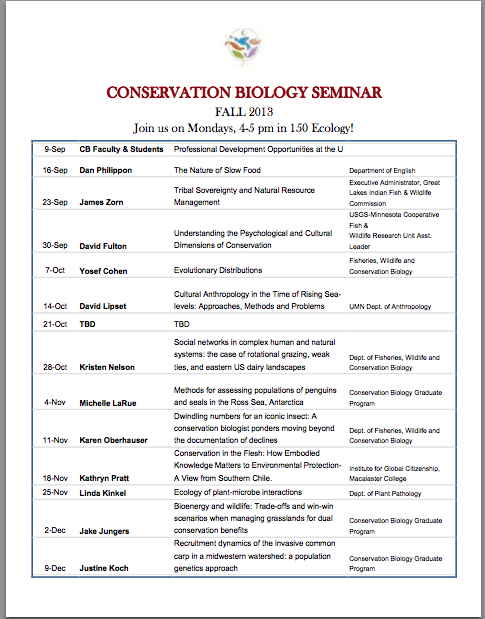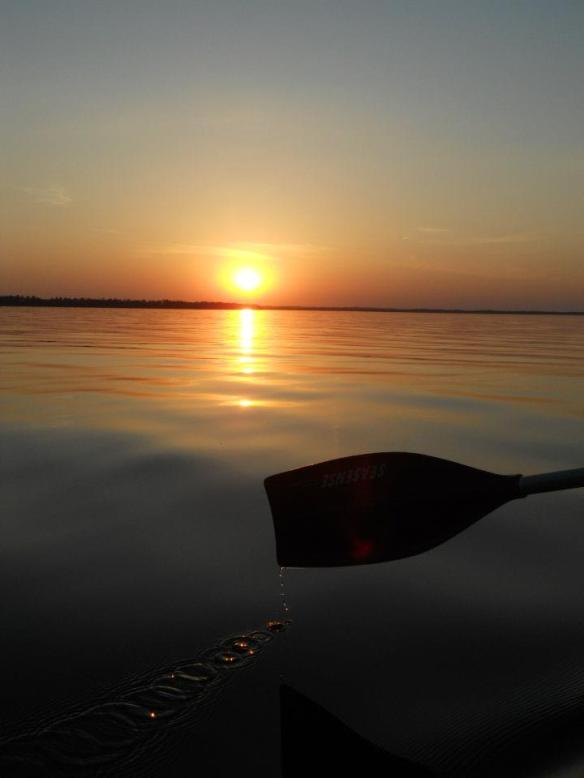Name: Jordan Rutter
Hometown: Silver Spring, MD
Other colleges/universities attended (undergrad and/or graduate): Oberlin College
Advisor: Francie Cuthbert
Degree anticipated: M.S.
Research interests: Bird Conservation Education –My project will be focused on piping plover outreach and public engagement in conservation in the Great Lakes region.
Favorite hobbies: Birding, Photography, Ceramics
Favorite thing that’s green: Green Jay
Last read: Deception Point by Dan Brown
Favorite place on Earth: Bird Rock in St. Mary’s, Newfoundland, Canada
Guilty pleasure: Tv shows/pop culture
Category Archives: Current Students
Get to Know the New Cons Bio Cohort 2014 edition (Part 1)
Name: Brittney Yohannes
Hometown: Lino Lakes, MN
Other colleges/universities attended (undergrad and/or graduate): Bethel University
Advisor: Dr. Todd Arnold
Degree anticipated: MS
Research interests: Red-headed Woodpecker nesting, all things avian
Favorite hobbies: birding, camping, video gaming, exploring the Twin Cities
Favorite thing that’s green: hummingbirds
Last read: The Alchemist by Paulo Coelho
Favorite place on Earth: the cloud forests of Mindo, Ecuador
Guilty pleasure: eating peanut butter and Nutella right out of the jars (usually mixed together)
Name: Ami Thompson
Hometown: Cedarburg, WI
Other colleges/universities attended (undergrad and/or graduate): UW-River Falls (B.S. in Conservation, minor in Geology)
Advisor: Rob Blair and Karen Oberhauser
Degree anticipated: leaning towards PhD
Research interests: Dragonflies and Damselflies
Favorite hobbies: Canoeing, Cooking, Yoga, Running, Dragonfly Catching
Favorite thing that’s green: Common Green Darner
Last read: Skinny Legs and All, Tom Robbins
Favorite place on Earth: Our slice of recreation land along Hall’s Creek near Black River Falls, WI
Guilty pleasure: Video Games
Link
CB PhD Student Jennifer Biederman featured on the Fisheries Blog
Current student Jennifer Biederman was featured as a guest contributor on the Fisheries Blog. Her post explores the relationship among reading, gender and science – and touches on what it’s like to be a new mom in graduate school. Enjoy!
Announcing Fall 2013 Seminar Series
Life and Boats
Editorial note: The following is a repost from http://lifeboat.com/blog/2013/03/life-and-boats by CB student Leif Devaney
 In an enormously influential article published in 1974 in Psychology Today, and in a longer version published later that year in BioScience, Garrett Hardin introduced the metaphor of the lifeboat for economic and ethical consideration. This conceptual construction was intended as an improvement over the then-popular ecological metaphor of “spaceship earth” coined by Kenneth Boulding in 1966. Interestingly, in the opening paragraph of “Living on a lifeboat”, Hardin indicates that metaphors in general may be understood as only an early stage in mentally approaching difficult problems, and that this stage may be surpassed as theory advances and becomes more rigorous.
In an enormously influential article published in 1974 in Psychology Today, and in a longer version published later that year in BioScience, Garrett Hardin introduced the metaphor of the lifeboat for economic and ethical consideration. This conceptual construction was intended as an improvement over the then-popular ecological metaphor of “spaceship earth” coined by Kenneth Boulding in 1966. Interestingly, in the opening paragraph of “Living on a lifeboat”, Hardin indicates that metaphors in general may be understood as only an early stage in mentally approaching difficult problems, and that this stage may be surpassed as theory advances and becomes more rigorous.
In Hardin’s analogy, large entities such as nations or the biosphere are likened to a boat, while smaller entities – for example, migrating individuals or groups – are likened to swimmers trying to board the already cramped vessel and exploit whatever resources are on board. In the imagined scenario, it is believed that the boat is near carrying capacity, but exactly how near is not known with certainty given the many future possibilities. A central question focuses on at what point, if any, the risk of sinking the entire boat outweighs the good provided for each additional rescued swimmer.
The metaphor of the lifeboat has structured thought about conservation, economics, ethics, and any number of other disciplinary areas for decades. The question I would like to pose is the following: Is the lifeboat scenario still (or was it ever) an apt metaphor for structuring thought about ethical conservation of resources, or have we reached a stage where the boat should be scuttled in favor of either a new metaphor or more literal language? Please feel free to post any thoughts you may have on this issue.
 About the author: Leif DeVaney is a PhD candidate in the Conservation Biology Program with a minor in Philosophy at the University of Minnesota, and obtained his MS in Conservation Biology from the U of MN in 2010. A native Minnesotan, Leif studied philosophy and biology at Bethel University as an undergraduate. His master’s research included a Q study focused on the conflict over all-terrain vehicle use on Minnesota public lands, and he has performed social science research with the USDA Forest Service. Leif is broadly interested in philosophy of conservation and the interactions of wildlife, humans, and technology, and his doctoral research is centered on an investigation of and argument for the compatibility of wildlife rehabilitation and conservation. Leif is advised by Dr. David Bengston.
About the author: Leif DeVaney is a PhD candidate in the Conservation Biology Program with a minor in Philosophy at the University of Minnesota, and obtained his MS in Conservation Biology from the U of MN in 2010. A native Minnesotan, Leif studied philosophy and biology at Bethel University as an undergraduate. His master’s research included a Q study focused on the conflict over all-terrain vehicle use on Minnesota public lands, and he has performed social science research with the USDA Forest Service. Leif is broadly interested in philosophy of conservation and the interactions of wildlife, humans, and technology, and his doctoral research is centered on an investigation of and argument for the compatibility of wildlife rehabilitation and conservation. Leif is advised by Dr. David Bengston.
——————————————————————————————————–
PLEASE NOTE: Opinion blogs do not necessarily represent the unanimous opinion of those affiliated with the Conservation Biology Program at the University of Minnesota. Rather, they are meant to broaden and elevate the educational and scientific discourse related to various topics in conservation biology
FWCB Quantitative Ecologist – candidate interviews week of 3/4
The FWCB department search for a new faculty position continues this week with Dr. John Fieberg. Dr. Fieberg will be visiting Tuesday 3/5 and Wednesday 3/6. He will be giving a research seminar at 3pm in Hodson 495 on Wednesday. Many faculty members in the Conservation Biology Graduate Program are based in FWCB. New faculty appointments have many important teaching and research implications for the department, as well as the CB graduate program. All students are strongly encouraged to attend the graduate student lunch and research seminar. Research seminars can be accessed through a link on the FWCB website (right side of page) if you cannot attend in person. Please contact Nancy Rothman in the FWCB office for more information about the candidates.
The graduate student lunch with Dr. Fieberg will be this Wednesday (3/6) in 100 Skok Hall (note new location) from noon to 1. We hope to see you there!
Dr. John Fieberg, Biometrician for the Minnesota Department of Natural Resources, Forest Lake, Minnesota. Dr. Fieberg received his Ph.D. in Biomathematics in 2000 from North Carolina State University. His research focuses on species distributions, event-time analysis, sightability surveys, and home range ecology.
Stay tuned for weekly blog posts about the candidates!
Cross-blogging on R
 CB doctoral candidate Marcus Beck has created an R-centric blog to highlight some tips and tricks he’s learned over the years. The focus is broad but he hopes to communicate some useful techniques using programmatic methods for data acquisition, organization, and analysis. He’s posted recent topics on data mining from the internet and modeling with different correlation structures. We encourage those of you that use R to head on over and have a look at some of his posts!
CB doctoral candidate Marcus Beck has created an R-centric blog to highlight some tips and tricks he’s learned over the years. The focus is broad but he hopes to communicate some useful techniques using programmatic methods for data acquisition, organization, and analysis. He’s posted recent topics on data mining from the internet and modeling with different correlation structures. We encourage those of you that use R to head on over and have a look at some of his posts!
We are always in search of new blogs and strongly encourage graduate students to submit blog contributions. Topics can be wide-ranging, so long as they are relevant to Conservation Biology. Check out our submission page for the full range of topics and contact information for submission. Also, cross-posts are welcome if you manage an independent blog.
Here’s to a productive Spring semester!
Featured Photo: Summer paddling in the U.P. by Sarah Saunders
The latest image header on our blog was provided by Sarah Saunders, a current student in UMN’s Conservation Biology program.
To describe her photo, Sarah writes “Few places in America are as spectacular as northern Michigan in the summer. The days are long and the temperatures are just right. This photo was taken on Douglas Lake at the University of Michigan Biological Station, where I’m based for my field work in the summer.”
Do you have a great photo that captures some amazing aspect of biodiversity? We’d love to feature it as a header on the Cons Bio Blog. To submit your photo, please email Jennifer Cochran-Biederman at coch0088@umn.edu.
Current Cons Bio grad student’s research featured in Nature film
Nature in HD, filmographers who specialize in capturing wildlife in the upper Midwest. spent some time with current graduate student Sarah Saunders and her research crew while conducting field work.
During the summers, the University of Minnesota banding crew travels throughout Michigan to band adults and chicks in the Great Lakes piping plover population in order to keep track of their numbers and identify individuals uniquely. Here, Nature in HD filmed a chick banding in Manistee on a hot July day. They began by using a spotting scope to look for the chicks on the beach, then slowly surrounded them and captured them with soft, harmless handheld nets. In total, the crew banded all 4 chicks and released them back to their parents.
Check out the video clicking this link.
Featured Photo: Aspen (Populus tremuloides) regeneration in a 2006 clear cut site by John Berini
The image header on our blog was provided by John Berini, a current PhD student in UMN’s Conservation Biology program. Taken during his 2012 summer field season at Finland State Forest, MN, the photograph depicts aspen (Populus tremuloides) regeneration in a 2006 clear cut site.

Do you have a great photo that captures some amazing aspect of biodiversity? We’d love to feature it as a header on the Cons Bio Blog. To submit your photo, please email Jennifer Cochran-Biederman at coch0088@umn.edu.





